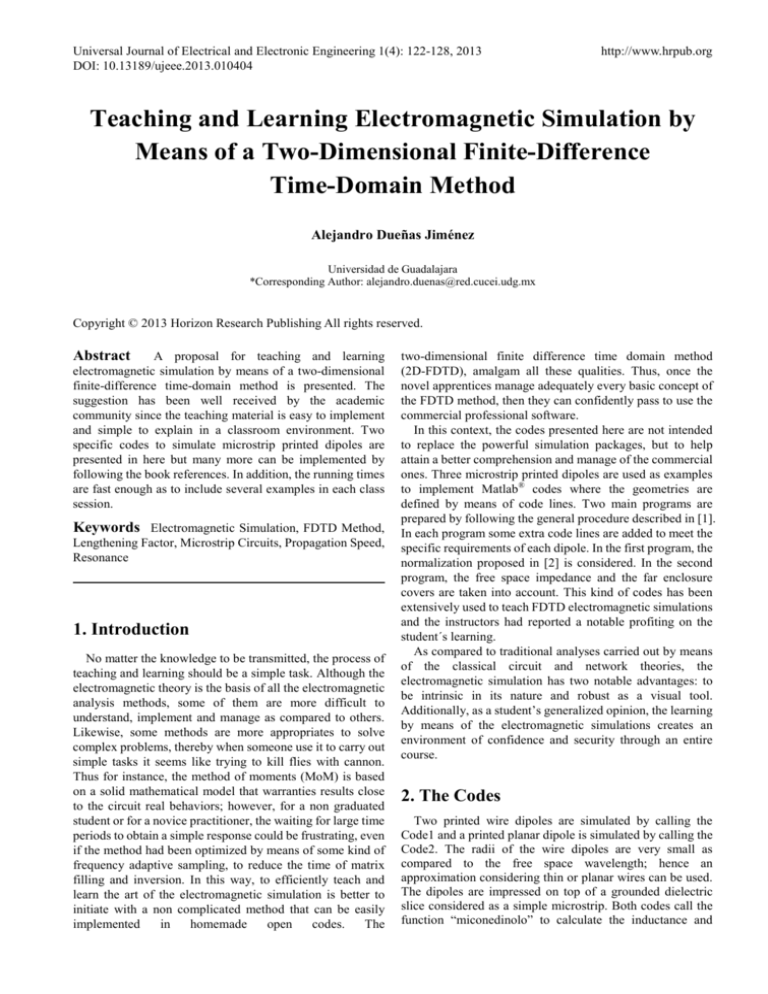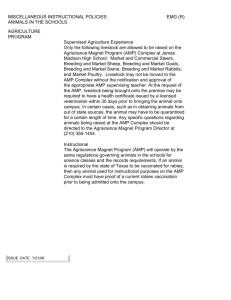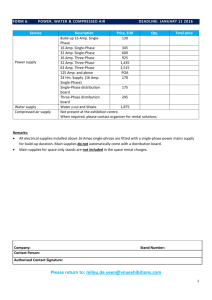
Universal Journal of Electrical and Electronic Engineering 1(4): 122-128, 2013
DOI: 10.13189/ujeee.2013.010404
http://www.hrpub.org
Teaching and Learning Electromagnetic Simulation by
Means of a Two-Dimensional Finite-Difference
Time-Domain Method
Alejandro Dueñas Jiménez
Universidad de Guadalajara
*Corresponding Author: alejandro.duenas@red.cucei.udg.mx
Copyright © 2013 Horizon Research Publishing All rights reserved.
Abstract
A proposal for teaching and learning
electromagnetic simulation by means of a two-dimensional
finite-difference time-domain method is presented. The
suggestion has been well received by the academic
community since the teaching material is easy to implement
and simple to explain in a classroom environment. Two
specific codes to simulate microstrip printed dipoles are
presented in here but many more can be implemented by
following the book references. In addition, the running times
are fast enough as to include several examples in each class
session.
Keywords Electromagnetic Simulation, FDTD Method,
Lengthening Factor, Microstrip Circuits, Propagation Speed,
Resonance
1. Introduction
No matter the knowledge to be transmitted, the process of
teaching and learning should be a simple task. Although the
electromagnetic theory is the basis of all the electromagnetic
analysis methods, some of them are more difficult to
understand, implement and manage as compared to others.
Likewise, some methods are more appropriates to solve
complex problems, thereby when someone use it to carry out
simple tasks it seems like trying to kill flies with cannon.
Thus for instance, the method of moments (MoM) is based
on a solid mathematical model that warranties results close
to the circuit real behaviors; however, for a non graduated
student or for a novice practitioner, the waiting for large time
periods to obtain a simple response could be frustrating, even
if the method had been optimized by means of some kind of
frequency adaptive sampling, to reduce the time of matrix
filling and inversion. In this way, to efficiently teach and
learn the art of the electromagnetic simulation is better to
initiate with a non complicated method that can be easily
implemented
in
homemade
open
codes.
The
two-dimensional finite difference time domain method
(2D-FDTD), amalgam all these qualities. Thus, once the
novel apprentices manage adequately every basic concept of
the FDTD method, then they can confidently pass to use the
commercial professional software.
In this context, the codes presented here are not intended
to replace the powerful simulation packages, but to help
attain a better comprehension and manage of the commercial
ones. Three microstrip printed dipoles are used as examples
to implement Matlab® codes where the geometries are
defined by means of code lines. Two main programs are
prepared by following the general procedure described in [1].
In each program some extra code lines are added to meet the
specific requirements of each dipole. In the first program, the
normalization proposed in [2] is considered. In the second
program, the free space impedance and the far enclosure
covers are taken into account. This kind of codes has been
extensively used to teach FDTD electromagnetic simulations
and the instructors had reported a notable profiting on the
student´s learning.
As compared to traditional analyses carried out by means
of the classical circuit and network theories, the
electromagnetic simulation has two notable advantages: to
be intrinsic in its nature and robust as a visual tool.
Additionally, as a student’s generalized opinion, the learning
by means of the electromagnetic simulations creates an
environment of confidence and security through an entire
course.
2. The Codes
Two printed wire dipoles are simulated by calling the
Code1 and a printed planar dipole is simulated by calling the
Code2. The radii of the wire dipoles are very small as
compared to the free space wavelength; hence an
approximation considering thin or planar wires can be used.
The dipoles are impressed on top of a grounded dielectric
slice considered as a simple microstrip. Both codes call the
function “miconedinolo” to calculate the inductance and
Universal Journal of Electrical and Electronic Engineering 1(4): 122-128, 2013
capacitance per unit length, the characteristic impedance and
the phase velocity on a microstrip considering neither the
dispersion nor the losses [4], [5]. The phase velocity is
corrected with the lengthening factor ( f l ) to obtain the
correct resonant frequency [6, 7]. This factor is expressed in
terms of the microstrip phase velocity v pm (which is taken
as the velocity on the printed dipole) and the phase velocity
on the dielectric v pd , in the following way [1]:
fl =
kv npm
v npd
(1)
where
v pm
=
c
1
= c = cvrp
ε eff
ε eff
v pd =
c
εr
k and n are positive numbers, k = p
(2)
(3)
(where p is
2
the number of ports in the circuit), n is experientially
chosen as a positive integer number, c is the free space
speed of light, ε eff is the effective dielectric constant, vrp
is the relative phase velocity and ε r is the relative
permittivity.
Thus,
v pmc
= v pm ⋅ f l
(4)
where f l is given by (1) for k= n= 1 .
To analyze a printed dipole with the MoM procedure, it is
necessary to assume a surface resistivity of 377 Ohms per
square on the upper and lower covers (ground plane) of the
box containing the circuit, and remove them a distance of at
least a half wavelength [3]. The correspondent with the
2D-FDTD technique described here is to move the ground
plane a similar distance through an increment on the
microstrip substrate thickness H, which will become in a
microstrip width W to thickness H (W/H) relation, out of the
recommended limits for a typical microstrip. The increment
in the substrate thickness corresponds to an increment in the
microstrip characteristic impedance, which should be a
considerable fraction of the free space impedance. By
following these directions, the two main programs and the
function subroutine can be written as follows:
%*************************************************************
% Code1.m
% A FDTD code to obtain the input impedance of a wire dipole printed on
% a grounded substrate.
%*************************************************************
%
Author: ALEJANDRO DUEÑAS JIMÉNEZ
%
Departamento de Electrónica
%
Universidad de Guadalajara
%
Av. Revolución No. 1500
%
44110 Guadalajara, Jalisco, México
%
Tel. 011 52 33 1378 5900, Ext. 7726
%
Version 1.0: July 2013
%*************************************************************
warning off, clear, clc
muz=4*pi*1e-7;
epsz=8.854e-12;
cz=1/(sqrt(muz*epsz));
lambda_0=input('Enter the normalized free-space wavelength: ');
% 4.85 for example 1; 2.5 for example 2
W=input('Enter the radius of the wire (in wavelengths): ')*2*lambda_0;
% 0.00005 for example 1; 0.000025 for example 2
P0=input('Enter the resonant length (in wavelengths): ');
% 0.317 for example 1; 0.23 for example 2
P1=round(((P0*lambda_0)/(W/3))/10);
P2=round(P1/2);
IV=9;
JV=P1;
KV=3+3;
LV=P1;
freqmi=0.375*1e9;
freqma=3.0*1e9;
freqce=(freqma+freqmi)/2;
freqstep=0.00125*1e9;
epsrm=input('Enter the substrate dielectric constant: ');
% 3.25 for example 1; 8.5 for example 2
epsrc=2.2;
vpd=1/(sqrt(muz*epsz*epsrm));
H=input('Enter the substrate thickness (in wavelengths): ')*lambda_0;
% 0.1016 for example 1; 0.15 for example 2
[ls1, cs1, Zo1, vpm] = miconedinolo(epsrm, epsz, H, W);
ddx=((W*vpm)/(3*vpd));
ddy=ddx;
123
124
Teaching and Learning Electromagnetic Simulation by Means of a Two-Dimensional
Finite-Difference Time-Domain Method
dt=ddx/(sqrt(2)*cz);
nsteps=input('Enter the number of time steps: ');
% 7000 for example 1; 14000 for example 2
nfreqs=((freqma-freqmi)/freqstep)+1;
freq(1:nfreqs)=freqmi:freqstep:freqma;
freqi(1:nfreqs)=freqma:-freqstep:freqmi;
arg(1:nfreqs)=2*pi*freq(1:nfreqs)*dt;
args(1:nfreqs)=2*pi*freq(1:nfreqs);
Lvp1=((dt*vpm)*ls1)/(2*ddx);
Lp1=(ls1/2)+Lvp1;
Zs=50.0;
ZL=50.0;
Zl=10000;
clc
v(1:IV,1:JV+1)=0;
jx(1:IV+1,1:JV)=0;
jy(1:IV,1:JV)=0;
amp_in(1:nfreqs)=0;
amp_1(1:nfreqs)=0;
amp_jy(1:nfreqs)=0;
amp_out(1:nfreqs)=0;
t0=20;
spread=4;
T=0;
for t=1:nsteps
T=T+1;
pulse=exp(-(0.5*((t0-T)^2)/(spread^2)));
v(4:KV,P2)=pulse;
jy(4:KV,2)=0.0;
v(4:KV,1)=jy(4:KV,2)*mean(Zl);
jy(4:KV,P2)=jy(4:KV,P2)-((v(4:KV,P2)-v(4:KV,P2))*Lp1);
v(4:KV,P2)=v(4:KV,P2)-(jy(4:KV,P2)*mean(Zs));
amp_in=amp_in+exp(-i*arg*T)*v(5,P2);
amp_1=amp_1+exp(-i*arg*T)*v(5,P2);
amp_jy=amp_jy+exp(-i*arg*T)*jy(5,P2);
amp_out=amp_out+exp(-i*arg*T)*v(5,LV+1);
jx(5:KV,1:LV)=jx(5:KV,1:LV)+(dt/(ls1*ddx))*(v(4:KV-1,1:LV)...
-v(5:KV,1:LV));
jy(4:KV,1:LV)=jy(4:KV,1:LV)+(dt/(ls1*ddy))*(v(4:KV,1:LV)...
-v(4:KV,2:LV+1));
v(4:KV,3:LV)=v(4:KV,3:LV)+(dt/(cs1*ddx))*(jx(4:KV,3:LV)...
-jx(5:KV+1,3:LV)-jy(4:KV,3:LV)+jy(4:KV,2:LV-1));
jy(4:KV,LV)=0.0;
v(4:KV,LV+1)=jy(4:KV,LV)*mean(Zl);
end
Zin=((amp_1./amp_jy).*exp(-i*arg/2))-((i*arg*vpm/2)*ls1);
plot(cz./freq(1:nfreqs),abs(Zin(1:nfreqs)),'-b')
hold on
plot(cz./freq(1:nfreqs),-imag(Zin(1:nfreqs)),'-g')
hold on
plot(cz./freq(88),abs(Zin(88)),'or')% for example 1
% plot(cz./freq(555),abs(Zin(555)),'or')% for example 2
hold on
plot(cz./freq(282),abs(Zin(282)),'or')% for example 1
% plot(cz./freq(270),abs(Zin(270)),'or')% for example 2
hold on
set(gca,'FontSize',18)
legend('|Zin|','Imag of Zin','Resonant','Frequencies',3)
plot(cz./freq(15:15:nfreqs),abs(Zin(15:15:nfreqs)),'ob')
hold on
plot(cz./freq(15:15:nfreqs),-imag(Zin(15:15:nfreqs)),'sg')
hold on
plot(cz./freq(88),-imag(Zin(88)),'or')% for example1
% plot(cz./freq(555),abs(Zin(555)),'or')% for example 2
% plot(cz./freq(555),-imag(Zin(555)),'or')% for example2
hold on
plot(cz./freq(282),-imag(Zin(282)),'or')% for example1
% plot(cz./freq(270),abs(Zin(270)),'or')% for example 2
% plot(cz./freq(270),-imag(Zin(270)),'or')% for example2
hold on
set(gca,'FontSize',18)
axis([0.4 0.80 -1800 3200])% for example1
% axis ([0.25 0.60 -800 1200])% for example 2
xlabel('L (in lambda)','FontSize',18)
ylabel('Ohms','Fontsize',18)
%____________________________________________________________
%*************************************************************
%
Code2.m
%
A FDTD code to obtain the reflection scattering parameter of a dipole
%
printed on a grounded substrate.
%*************************************************************
%
Author: ALEJANDRO DUEÑAS JIMÉNEZ
Universal Journal of Electrical and Electronic Engineering 1(4): 122-128, 2013
%
Departamento de Electrónica
%
Universidad de Guadalajara
%
Av. Revolución No. 1500
%
44110 Guadalajara, Jalisco, México
%
Tel. 011 52 33 1378 5900, Ext. 7726
%
Version 1.0: July 2013
%*************************************************************
warning off, clear, clc
ADJ=input('Enter the sweep of the dipole length: ');
% 3; 6; 9; 12; 15; 18; 21; 24; 27; 30
IV=9;
JV=186+ADJ;
KV=3+3;
LV=186+ADJ;
freqmi=0.0*1e9;
freqma=1.2*1e9;
freqce=(freqma+freqmi)/2;
freqstep=0.001*1e9;
epsrm=3.0;
muz=4*pi*1e-7;
epsz=8.854e-12;
epsrc=2.2;
cz=1/(sqrt(muz*epsz));
freqre=0.954*1e9;
vpd=1/(sqrt(muz*epsz*epsrm));
H=input('Enter the normalized substrate thickness: ');
% 0.8
W=0.002;
[ls1, cs1, Zo1, vpm] = miconedinolo(epsrm, epsz, H, W);
% W/H Recommended >=0.05
ddx=((W*vpm)/(3*vpd));
ddy=ddx;
dt=ddx/(sqrt(2)*cz);
nsteps=input('Enter the number of time steps: ');
% 2000 for example 3
nfreqs=((freqma-freqmi)/freqstep)+1;
freq(1:nfreqs)=freqmi:freqstep:freqma;
freqi(1:nfreqs)=freqma:-freqstep:freqmi;
arg(1:nfreqs)=2*pi*freq(1:nfreqs)*dt;
args(1:nfreqs)=2*pi*freq(1:nfreqs);
Lvp1=((dt*vpm)*ls1)/(2*ddx);
Lp1=(ls1/2)+Lvp1;
Zs=50.0;
ZL=50.0;
Zl=10000;
clc
v(1:IV,1:JV+1)=0;
jx(1:IV+1,1:JV)=0;
jy(1:IV,1:JV)=0;
amp_in(1:nfreqs)=0;
amp_1(1:nfreqs)=0;
amp_jy(1:nfreqs)=0;
amp_out(1:nfreqs)=0;
t0=20;
spread=4;
T=0;
for t=1:nsteps
T=T+1;
pulse=exp(-(0.5*((t0-T)^2)/(spread^2)));
v(4:KV,102)=pulse;
jy(4:KV,2)=0.0;
v(4:KV,1)=jy(4:KV,2)*mean(Zl);
jy(4:KV,102)=jy(4:KV,102)-((v(4:KV,102)-v(4:KV,102))*Lp1);
v(4:KV,102)=v(4:KV,102)-(jy(4:KV,102)*mean(Zs));
amp_in=amp_in+exp(-i*arg*T)*v(5,102);
amp_1=amp_1+exp(-i*arg*T)*v(5,102);
amp_jy=amp_jy+exp(-i*arg*T)*jy(5,102);
amp_out=amp_out+exp(-i*arg*T)*v(5,LV+1);
jx(5:KV,1:LV)=jx(5:KV,1:LV)+(dt/(ls1*ddx))*(v(4:KV-1,1:LV)...
-v(5:KV,1:LV));
jy(4:KV,1:LV)=jy(4:KV,1:LV)+(dt/(ls1*ddy))*(v(4:KV,1:LV)...
-v(4:KV,2:LV+1));
v(4:KV,3:LV)=v(4:KV,3:LV)+(dt/(cs1*ddx))*(jx(4:KV,3:LV)...
-jx(5:KV+1,3:LV)-jy(4:KV,3:LV)+jy(4:KV,2:LV-1));
jy(4:KV,LV)=0.0;
v(4:KV,LV+1)=jy(4:KV,LV)*mean(Zl);
end
Zin=((amp_1./amp_jy).*exp(-i*arg/2))-((i*arg*vpm/2)*ls1);
S11=(Zin-50)./(Zin+50);
S11m=abs(S11);
S11dB=20*log10(S11m);
S11a=angle(S11);
S11ad=S11a*180/pi;
125
126
Teaching and Learning Electromagnetic Simulation by Means of a Two-Dimensional
Finite-Difference Time-Domain Method
subplot(2,1,1)
plot(freq/1e9,S11dB(1:nfreqs),'b')
hold on
set(gca,'FontSize',18)
axis ([0.8 1.2 -12 0])
xlabel('Frequency (MHz)','FontSize',18)
ylabel('|S11| in dB','Fontsize',18)
subplot(2,1,2)
plot(freq/1e9,S11ad(1:nfreqs),'g')
hold on
set(gca,'FontSize',18)
axis ([0.8 1.2 -40 40])
xlabel('Frequency (MHz)','FontSize',18)
ylabel('Angle of S11','Fontsize',18)
%____________________________________________________________
%*************************************************************
%
miconedinolo.m
%
A function to obtain the characteristic impedance of a microstrip
%
considering neither dispersion nor losses.
%*************************************************************
%
Author: ALEJANDRO DUEÑAS JIMÉNEZ
%
Departamento de Electrónica
%
Universidad de Guadalajara
%
Av. Revolución No. 1500
%
44110 Guadalajara, Jalisco, México
%
Tel. 011 52 33 1378 5900, Ext. 7726
%
Version 1.0: July 2013
%*************************************************************
function[ls, cs, Zo, vpm] = miconedinolo(epsrm, epsz, H, W)
suma1=0;
sumina1=0;
suma2=0;
sumina2=0;
pd=H;
pa=100*pd;
pt=0.000017;
for k=1:2:501
suma1=(4*pa*sin((k*pi*W)/(2*pa))*sinh((k*pi*pd)/(pa)))/...
((k*pi)^2*W*epsz*(sinh((k*pi*pd)/(pa))+epsrm*cosh((k*pi*pd)/(pa))));
sumina1=suma1+sumina1;
cs=1/sumina1;
suma2=(4*pa*sin((k*pi*W)/(2*pa))*sinh((k*pi*pd)/(pa)))/...
((k*pi)^2*W*epsz*(sinh((k*pi*pd)/(pa))+cosh((k*pi*pd)/(pa))));
sumina2=suma2+sumina2;
co=1/sumina2;
end
epse=cs/co;
if W/pd<=1.0
Zo=(60.0/sqrt(epse))*log(((8*pd)/(W))+((W)/(4*pd)));
else
Zo=(120*pi)/(sqrt(epse)*(((W)/(pd))+1.393...
+(0.667*log(((W)/(pd))+1.444))));
end
ls=(Zo^2)*cs;
vpm=3e8/(sqrt(epse));
%____________________________________________________________
3. The Simulations
Table I. Input parameters for the printed wire dipole examples 1 and 2
Printed dipole example
1
2
Normalized free space
wavelength
4.85
2.5
Wire radius in λ0 (a)
0.00005
0.000025
Resonant length in λ0 (L)
0.317
0.23
3.25
8.5
0.1016
0.15
7000
14000
Substrate dielectric constant
(εr)
Substrate thickness in
λ0 (B)
Time steps
As mentioned at the introduction, the best way to teach
electromagnetic simulation is by means of a simple method
as the 2D-FDTD. Different to the old empiric analytical
techniques [8], [9] and to the very sophisticated methods [10],
[11], the 2D-FDTD method offers rapid and confident first
approximation simulations that can be useful to feedback
other advanced methods [12], [13], [14]. These advantages
are profited in the simulations here realized to introduce a
real time teaching process. The Table 1 shows the necessary
input parameters to simulate two different printed wire
dipoles by means of Code1. As in [2], all pertinent
dimensions are normalized to the free space wavelength λ0
(lambda). The input parameters to simulate the third example,
Universal Journal of Electrical and Electronic Engineering 1(4): 122-128, 2013
which consists of a printed planar dipole (Code2) are simply
a sweeping of the dipole length, which varies from 3 to 30 in
steps of 3, a normalized substrate thickness of 0.8, and the
time steps to complete the simulation which are 2000.
3000
considered as the wire radii instead of the diameters, thereby
the results are different to those shown in [2]. The responses
of the printed planar dipole are shown in Fig. 3.
As can be seen from this figure, the resonant frequency
can be found around 950 MHz corresponding to a
wavelength of 31.557 cm on free space.
2500
0
|S11| in dB
2000
Ohms
1500
-5
-10
0.8
0
-1000
-1500
|Zin|
Imag of Zin
Resonant
Frequencies
0.4
0.5
0.6
L (in lambda)
0.7
0.8
Figure 1. Input impedance versus resonant length (in λ0) for a printed wire
dipole with a = 0.00005 λ0, L = 0.317 λ0, εr = 3.25 and B = 0.1016 λ0.
The planar dipole has a width of 0.2 cm, a length varying
from 12.6 to 14.4 cm, and a substrate dielectric constant of 3
with thickness of 0.05 cm.
1200
800
600
400
0
-200
-600
-800
0.25
1
Frequency (GHz)
1.1
1.2
0.9
1
Frequency (GHz)
1.1
1.2
|Zin|
Imag of Zin
Resonant
Frequencies
0.3
0.35
20
0
-20
-40
0.8
Figure 3. S11 parameter of a printed planar dipole versus frequency. The
planar dipole has a 0.2 cm width, a length varying from 12.6 to 14.4 cm and
a substrate with a dielectric constant of 3 and a thickness of 0.05 cm.
4. Conclusion
A simple strategy for teaching and learning
electromagnetic simulation was presented. The 2D-FDTD
method proved to be a good tool for this purpose. Two codes
and a function were written in Matlab® language to find the
responses of three different microstrip printed dipoles. The
algorithms are easy to implement and modify giving very
fast responses. However, the user should be careful since an
oversimplification of those could generate significant errors,
mainly on the more important parameters to be assessed,
which are the input impedance and the reflection coefficient
1000
-400
0.9
40
Angle of S11
-500
Ohms
127
0.4
0.45
L (in lambda)
0.5
0.55
0.6
Figure 2. Input impedance versus resonant length (in λ0) for a printed wire
dipole with a = 0.000025 λ0, L = 0.23 λ0, εr = 8.5 and B = 0.15 λ0.
The responses of the printed wire dipoles are shown in
Figs, 1 and 2. As can be seen from Fig. 1 or by running the
Code1, the first wire dipole presents a resonant frequency of
around 483.75 MHz corresponding to a wavelength of
61.973 cm on free space. Similarly, from Fig. 2 or by
executing once again the Code1, the second wire dipole
presents a resonant frequency of around 711.25 MHz
corresponding to a wavelength of 42.151 cm on free space.
In these examples the microstrip widths have been
REFERENCES
[1]
A. Dueñas Jiménez, 2-D Electromagnetic Simulation of
Passive Microstrip Circuits, CRC Press a Taylor and Francis
Company, Boca Raton, Florida, 2009, 274 pp.
[2]
I. E. Rana and N. G. Alexopoulos, “Current distribution and
input impedance of printed dipoles”, IEEE Trans. Antennas
and Propagat., vol. AP-29, pp. 99-105, Jan. 1981.
[3]
Anon., Using electromagnetic analysis for RFID antenna
design, Sonnet Application Note: SAN-206A, Sonnet
Software, Inc., 2006.
[4]
E. O. Hammerstad, Equations for microstrip circuit design,
in 1975 Proceedings of 5th European Microwave
Conference, pp. 268–272.
128
Teaching and Learning Electromagnetic Simulation by Means of a Two-Dimensional
Finite-Difference Time-Domain Method
[5]
D. M. Pozar, Microwave Engineering,
Massachusetts: Addison-Wesley, 1990, 726 pp.
[6]
A. Dueñas Jiménez, “Frequency- and time-domain simulation
of microstrip squares by using 2D-FDTD electromagnetic
analyses,” published in the International Workshop on Recent
Advances in Microwave & Optical Communication
Technology Proceedings, in association with 12th Int. Symp.
Microw. Opt. Tech., SRM University, Chennai, India, Dec.
2009.
Reading,
[7]
A. Dueñas Jiménez, “Frequency- and time-domain simulation
of microstrip squares by using 2D-FDTD electromagnetic
analyses,” Int. Journal Microw. Opt. Tech., vol. 5, pp. 1-6,
Jan. 2010.
[8]
D. A. Huebner, “An electrically small microstrip dipole
planar array,” in Proc. Workshop on Printed Circuit Antenna
Technol., Las Cruces, NM, Oct. 1979, pp. 17.1-17.16.
[9]
H. G. Oltman and D. A. Huebner, “Electromagnetically
coupled microstrip dipoles,” IEEE Trans. Antennas
Propagat., vol. AP-29, pp. 152-158, Jan. 1981.
[10] P. P. Silvester and R. L. Ferrari, Finite Elements for
Electrical Engineers, Cambridge University Press,
Cambridge, 1983.
[11] T. Weiland, A discretization method for the solution of
Maxwell’s equations for six-component fields, Electronics
and Communication (AEU), vol. 31, p. 116, 1977.
[12] R. F. Harrington, Field Computation by Moment Methods,
Macmillan, New York, New York, 1968.
[13] A. Taflove and S. C. Hagness, Computational
Electrodynamics the Finite-Difference Time-Domain Method,
Artech House, Norwood, Massachusetts, 2000.
[14] D. M. Sullivan, “Electromagnetic Simulation Using the
FDTD Method, IEEE Press, Piscataway, New Jersey, 2000.






